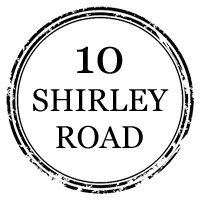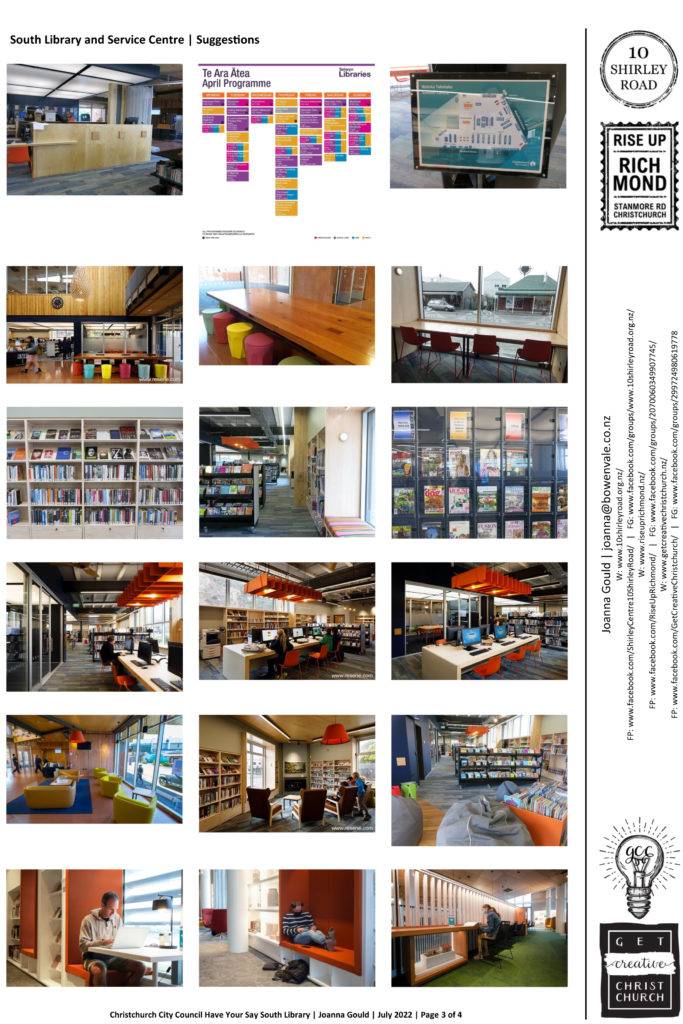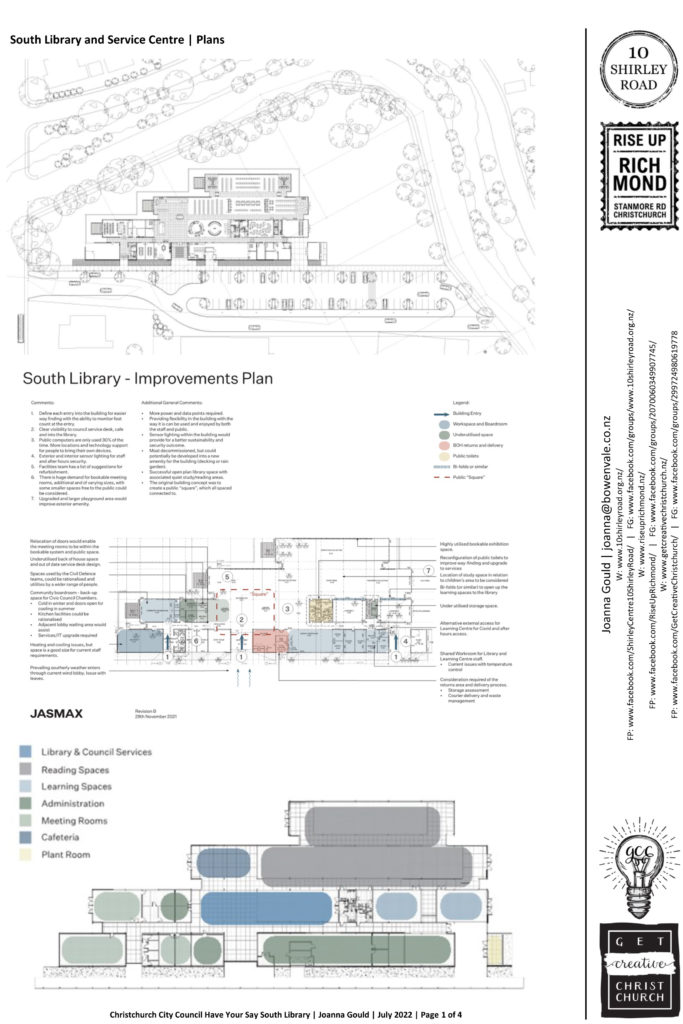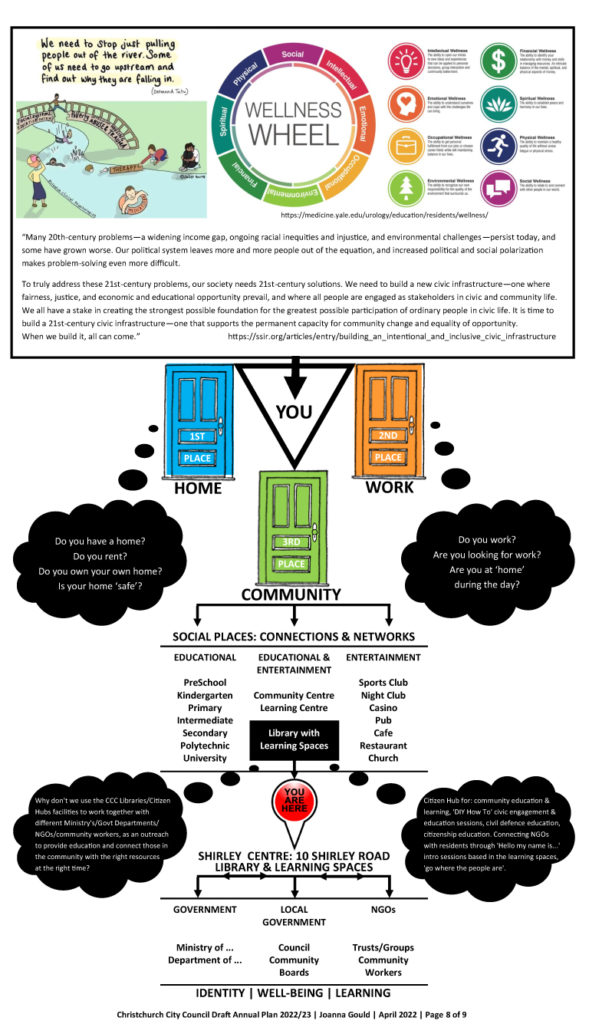“Review into the Future for Local Government”
https://www.futureforlocalgovernment.govt.nz/
“Review into the Future for Local Government”: Draft Report
https://www.futureforlocalgovernment.govt.nz/assets/Reports/Draft-report-final.pdf
“Review into the Future for Local Government” Draft Report – Webinar
I watched the public webinar, presented by the Panel, which was recorded on 2 Feb 2023: https://youtu.be/e48NLRovj-M
My submission for the “Review into the Future for Local Government” Interim Report:
https://www.10shirleyroad.org.nz/review-into-the-future-for-local-government/
“A report has found libraries have ‘untapped potential’ to provide their communities with more than just books.
Local Government New Zealand (LGNZ) wants to see libraries diversify to be community hubs servicing readers and ratepayers. And some places have already adapted…After conducting a report into the future of libraries, LGNZ wants to see models like this rolled out across the country.
“There’s so much more potential in libraries…and they could be really one-stop shops,” said LGNZ CEO Susan Freeman-Greene.
That potential is endless. LGNZ believes libraries can host services including healthcare, financial support, education – all sorts of support…The only barrier right now is funding. It wants local and central governments to partner up on costs because those areas that’ve already adapted can prove it’s worth it. Like in Selwyn.”
https://www.newshub.co.nz/home/new-zealand/2023/01/libraries-could-become-community-hubs-to-stay-relevant-report.html
Libraries are ‘third places (social)’ the ‘living room’ of society in our communities.
We have many in our communities who don’t have a ‘second place (work)’: stay at home parents, caregivers, retirees, unemployed, people working from home etc. Some due to their circumstances don’t feel like they have a safe and relaxing ‘first place (home)’.
This is why it is so important that our ‘third places (social)’ are welcoming and inclusive for everyone in our communities.
“What if public libraries were open late every night and we could engage in public life there, instead of having to choose between drinking at the bar and domestic isolation.”
Erin Glass
“Libraries allow children to ask questions about the world and find the answers.
And the wonderful thing is that once a child learns to use a library, the doors to learning are always open.”
Laura Bush
Libraries are intergenerational ‘bumping spaces’ that provide opportunities for all ages to connect, to be seen, be heard & to belong…
“I became something of a lost soul…I’m just a run-of-the-mill guy, who just does something which has helped me get through my week…I belong. I belong. I’m not this old man who lives on his own. I’m part of the community which is great.”
100-year-old Peter Davies started volunteering teaching children how to read, after his wife died: https://fb.watch/iY9p4b1Rdo/
“In an age of ever-increasing unaffordable housing, increasing privatisation and control of urban space, along with public services moving online or closing altogether, people with complex needs are increasingly forced to live out their private lives in these public spaces like libraries. As a result, we are seeing the role of public libraries changing.”
Lessons from the Central Hub. Safe Spaces Pilot Project.
By Anna Lockwood, Senior Advisor Inclusive Services, Auckland Council Connected Communities, 1 Feb 2023, Page 7-9, https://lianza.pressreader.com/library-life
“I love public libraries because they are built on the principle that books are so important and so necessary to human flourishing that access to them cannot depend on your income.”
Icona @iconawrites
Community Education: Well-being WOF/Tool Kit’ & ‘While You Wait’
https://www.10shirleyroad.org.nz/community-education/
“Jason Joseph, mental health lead for Suffolk and North East Essex Integrated Care System said the service helped prevent escalation…help and signposting to other support services was given by specially-trained library staff and volunteers, or people from the Mental Health Trust teams…many people were isolated, but ‘having a space where they can come out of their house is a huge benefit to them’…We don’t want library services to be seen as a replacement for GPs or statutory mental health services, that’s not their job. But what they can do is some of the early intervention prevention work with people, before they get to a point when they might be in crisis.”
https://www-bbc-com.cdn.ampproject.org/c/s/www.bbc.com/news/uk-england-suffolk-64662118.amp
‘Participate, Engage, Observe’
‘You don’t know what you need to know, until you need to know it.’
‘I wish I had known about that organisation sooner’ & ‘I wish they taught that at school.’
Instore demonstrations work with the flow of people in a supermarket & are positioned accordingly.
Shoppers usually have one of three reactions:
1. Participate (stop & engage with demonstrator),
2. Engage (walk passed & take what is handed to them by the demonstrator),
3. Observe (watches & listens by shelves close to the demonstrator)
The same principles would work if we integrated support services into our library learning spaces:
1. Participate: support services can invite residents to learn more about their services or hold weekly/monthly meetings.
2. Engage: support services ‘demonstrators’ become a familiar face, in residents local ‘safe’ place, more accessible ‘bumping’ space.
3. Observe: residents are now aware of this support service, they might not need their help at this time or they might remember this support services & refer someone else to it. Residents might not be comfortable approaching ‘demonstrators’ in a public place & may reach out to the support service in private. Some residents who have trust issues, will need to see the support service or ‘demonstrator’ more than once, before they decide it is ‘safe’ to ‘participate’ or ‘engage’.
https://www.10shirleyroad.org.nz/instore-demonstration-concept/
Bringing support services into our local libraries learning spaces, provides opportunities for residents to be informed & connect with the ‘demonstrator’, in a safe known local environment.
‘Demonstrations’ provide bumping space opportunities for residents to connect with others in their situation, like minded people with similar issues/interests.
Our local librarians are ‘information specialists’, who can provide information/contact details to residents about the ‘demonstrator’/support service, when they enquire at a later date.
“The Loft is a new way for the people of Canterbury to access a wide range of health and wellbeing services. Located on the first floor of the Eastgate Shopping Centre [next to the Christchurch City Libraries Linwood suburban library, https://maps.app.goo.gl/1sB7wHVAa1MkH8Di9], in Christchurch’s eastern suburbs.”
https://www.theloftchristchurch.org.nz/
“The Loft offers a free and confidential Social Emergency Response Service (SERS) for those in need of social and wellbeing support. We will talk to you about what difficulties are happening for you and develop a plan.”
https://www.theloftchristchurch.org.nz/The-Loft-Service/
The Loft Community and Social Services
https://www.theloftchristchurch.org.nz/Our-Services/
“We listened to peoples stories, and offered everyone who came to us immediate support, advice and advocacy.
We completed 899 assessments [during 2022] where we rapidly connected people to services they needed, making over 1000 referrals to other agencies.
– 83% were women
– Our clients had a total of 740 tamariki and rangatahi in their care
– Ethnicity: 67% NZ European, 23% Māori, 5% Asian, 5% Pacifica, 5% Other
– Issues: 320 Family or Sexual Violence, 234 Financial/Budgeting, 221 Mental Health, 205 Housing, 201 Safety Concerns, 194 Access and Custody, 93 Addiction, 89 Parenting, 227 Other”
https://www.facebook.com/TheLoftChristchurch/posts/pfbid02ofLM4aHJyxoypxGAj9a5dysq9KiNrX8sek8wVbAKnftNx7v11dYJ3Gj6TaVHnhsol
Community Education: Civic Education/Engagement/Participation
How does the Council work? What are the different Units for?
How does the Community Board work?
What do the different roles in Council/Community Board do?
How do I participate/engage with Council/Community Board?
https://ccc.govt.nz/the-council/how-the-council-works
https://ccc.govt.nz/the-council/how-the-council-works/council-committees/
https://ccc.govt.nz/the-council/how-the-council-works/elected-members/community-boards/
https://ccc.govt.nz/the-council/how-the-council-works/elected-members/representation/
“Civic Education 101” classes for residents, should be made available online & at our local suburban libraries. Covering: steps to positively engage with elected members & council/community board staff, how Council/Community Board meetings are run, how to speak at Council/Community Board meetings, how to lay a complaint regarding Council/Community Board/Elected Members/Residents Association/Community Group, how to become a candidate in Council/Community Board elections.
“Civic Engagement 101’ classes for elected members/candidates, should be made available online & through workshops at Council. Covering: steps to positively engage with residents, how to address/follow up resident queries/issues, social media accounts/posts/comments & how to be available in your Ward for residents: community activities/events, ‘Meet your Elected Member’ drop in sessions at local suburban library, while campaigning, during local emergencies & onsite visits to discuss local issues.
“Civic Participation 101’ classes for council/community board staff, should be made available online & through workshops at Council. Covering: steps to positively engaging with residents, how to address/follow up resident queries/issues, how to run Council/Community Board meetings so residents attending understand what is happening, how to help residents prepare to speak at Council/Community Board, how to help residents apply for funding at Council/Community Board, how to help residents setup a residents association/community group, how to help residents if they have an issue with Council/Community Board/Elected Members/Residents Association/Community Group.
Community Education: “Climate Change 101”
Climate change is a big picture issue. How can we break it down into achievable practical day to day tasks/changes to the way we live in Christchurch/NZ?
‘Live Local, Go Local’: promoting buying/renting home near where you work/go to school/play/shop/community facilities etc.
‘Where we live versus where we work’: https://storymaps.arcgis.com/stories/6f8b5f981ad34f11bedaf1725e9cb698
I try to ‘Live Local & Go Local’, apart from my weekly visits to the library.
My local Shirley Library is only 600m from my home, but I travel 5.4km to the Fendalton Library: https://maps.app.goo.gl/wR6fvq2zXWjcPkp46.
The Fendalton Library is a destination space situated next to Jeffreys Reserve/Playground, which is better for community wellbeing.
Free parking is available close to the building & there are a wider range of books/activities/events available.
I pay the $2 reserve fee for each book to be delivered to the Fendalton Library, instead of travelling to other libraries.
I drive an EV, charging only at night during the free 3 hours time slot from 9pm.
I could drive further to the other Christchurch City Libraries suburban libraries to pick up books, but I choose not to add to the already congested roads.
Libraries continue to evolve their service delivery to meet the needs of the community
“Public libraries drive literacy and life-long learning. Beyond books and reading, libraries operate as the access point for literacy of all types, including financial literacy, digital literacy, design literacy, information literacy, and health and wellbeing literacy. Increasingly, libraries are providing access to critical services that support and improve the wellbeing of their communities.”
Libraries are trusted institutions in their communities
“Libraries operate as established places of information and support for communities, often acting as a foundation for government engagement with communities. Libraries reflect the language and cultural diversity of their community and foster relationships and networks that enable them to be best placed to respond to the needs of their community. It is generally agreed that the indispensable “value-add” of libraries comes from the personal and institutional relationships (across community members and organisations) as well as the networks (both community and nationwide) that libraries support.”
Delivering through libraries can lower operating costs for central/local government
“Leveraging the knowledge, local connections and relationships of library staff can increase the engagement with and uptake of government services, as well as lowering the operational costs for government. Library staff are usually well placed within the community, with established relationships and local knowledge which can facilitate more efficient engagement with government services. Rather than a new entity, agency or person entering the community and applying a broad, nationwide delivery model, leveraging the expertise of local libraries can improve efficiency and create potential cost-savings.”
Project Summary: Libraries as a vehicle for service delivery
FrankAdvice prepared the report for Local Government New Zealand (LGNZ), January 2023, http://ow.ly/5UwU50MWCE6.
“Everyone of us needs help at some point in our life. And, the more that we can lift up those who need it the most in our community, the more the community itself betters.”
John Rivers
“ripples:
when you create a difference in someone’s life, you not only impact their life, you impact everyone influenced by them throughout their entire lifetime.
no act is ever too small. one by one, this is how to make an ocean rise.”
“Tangata ako ana i te kāenga, te tūranga ki te marae, tau ana.
A person nurtured in the community contributes strongly to society.”
Everyone needs a free, safe, inclusive & accessible place in our local communities:
Where they belong
Where they are seen
Where they are heard
Where they can be themselves
Where they have the opportunity to connect with others in their local communities & find their own circle of friends.
Shirley Community Centre (former Shirley School)
I created https://www.10shirleyroad.org.nz/ to collate my research and ideas for my submission to the Christchurch City Council 2018 Long Term Plan, for the rebuild of the Shirley Community Centre, 10 Shirley Road, Richmond, Christchurch.
“Are you saying that rather than just building back a community centre, that actually we should look at the whole of the area, and look at the whole of the needs.
So maybe what we need to be considering for the Long Term Plan is a budget that would enable a full needs analysis, and to look at what the different options are.”
Former Mayor Lianne Dalziel – 12th May 2018
https://www.facebook.com/ShirleyCentre10ShirleyRoad/
From 1915 to 2012, when the building was demolished after earthquake damage, this site at 10 Shirley Road, Richmond, Christchurch, has historically been a ‘place of learning’ in our communities, for our residents.
https://www.10shirleyroad.org.nz/timeline/ (from 2012-2019, as I stopped updating it)
https://www.10shirleyroad.org.nz/christchurch-suburb-overlooked/
Renewed calls to rebuild Shirley Community Centre – 1 December 2020
Residents are calling for the revival of the Shirley Community Centre after the area has been left without a facility for nearly a decade.
It comes after the Papanui-Innes Community Board sought ideas for the future use of the former community centre site at 10 Shirley Rd.
Due to Christchurch City Council’s financial restraints, it is unlikely that funding would be available in the short-term for permanent options.
In September, a questionnaire was delivered to about 800 properties within the site’s vicinity, asking residents whether they currently used the site, how they would like to use it, and how the city council can make the most of what was already there?
The city council received 58 submissions.
Shirley Recreational Walkers leader Sue Lang wants to see the centre reinstated and feared it might not happen after the rebuild was deferred for a number of years.
“I would like to see the Shirley Community Centre reinstated back at this site as we were led to believe it would be happening back in 2017,” Lang said in her submission.
“It is on a great bus route and was used by many groups both day and night. Other areas have had their community centres re-built, but not Shirley. Why?”
Prior to the September 4, 2010, and February 22, 2011, earthquakes, the well-established centre was used by many community groups to host workshops, classes and fun activities.
Due to the building’s damage caused by the earthquakes, the facility was demolished in 2012 and has not been replaced since, in spite of the area’s growing population.
https://www.odt.co.nz/star-news/star-christchurch/renewed-calls-rebuild-shirley-community-centre
The former Shirley Community Centre location at 10 Shirley Road, Richmond (https://maps.app.goo.gl/JhZdQboE1WXXvHov9) includes the Shirley Community Reserve/Playground (https://maps.app.goo.gl/pri5Ug86LTUQFJXj6) & Shirley Playcentre (https://maps.app.goo.gl/E8FVhXcjTqimzeq58).
This location connects the communities & residents living in the adjoining Innes & Central Ward, by our two main roads (Hills, Shirley) & bus stops located on either side of Shirley Road.
https://smartview.ccc.govt.nz/map/layers/bus-routes;bus-position;bus-stops#/@172.65369,-43.50847,16
Currently there is no ‘suburban’ library in the Innes Ward & Central Ward (with the new boundary changes).
https://ccc.govt.nz/the-council/how-the-council-works/council-elections/voting-areas/
Facilities and amenities: 3 Council libraries: Tūranga (metropolitan, distance to parking buildings, parking fees), Redwood, Papanui
https://ccc.govt.nz/culture-and-community/statistics-and-facts/community-profiles/papanui-innes-central/
Facilities and amenities: 5 Council libraries: Parklands, New Brighton, Aranui, Shirley, Linwood
https://ccc.govt.nz/culture-and-community/statistics-and-facts/community-profiles/coastal-burwood-linwood/
Our current Shirley Library (https://maps.app.goo.gl/ZS9ycmpvGcWxXVdz5) is located in the carpark of The Palms Shopping Centre, in the Burwood Ward & isn’t located near bus stops for our main bus routes.
“Her deputation focused on Shirley Library and the former Shirley Community Centre. She questioned the priority on South Library, when Shirley Library has issues around variety of books available and capacity. She also queried why the rebuild of the Shirley Community Centre has been delayed until 2030/31, and whether this aligns with the Council’s policies on sustainability and environmental outcomes.”
https://www.10shirleyroad.org.nz/south-library-report/
In the recent Innes ward of the Waipapa Papanui-Innes-Central Community Board By-election, the voter return was 21.23%, being 3,540 votes.
https://ccc.govt.nz/assets/Documents/The-Council/How-the-Council-works/Elections/2023-elections/Christchurch-City-Council_2023-Innes-Ward_Community-Board-By-election-Final-Result.pdf
Over 1,200 residents signed the petition for a new building to be built at 10 Shirley Road.
https://www.10shirleyroad.org.nz/where-is-our-community-centre-petition/
Study to determine feasibility of Christchurch community centre – 16 July 2021
The old community centre at 10 Shirley Rd was demolished following the February 22, 2011, earthquake. But Christchurch City Council’s Long Term Plan, approved last month, allocates $3 million towards a centre rebuild in the 2031-2032 financial year.
It also budgets $35,000 for a feasibility study to take place in the 2021-2022 financial year.
Innes Ward city councillor Pauline Cotter said the future of the project is in the hands of the community.
“It’s now with the community, they’re going to have to drive that,” Cotter said.
It is possible the $3 million funding could be brought forward if a building plan was ready and viable, she said.
https://www.odt.co.nz/star-news/star-christchurch/study-determine-feasibility-christchurch-community-centre
Yet we are still waiting for a feasibility study & funding isn’t on budget until 2030/2031?
https://www.10shirleyroad.org.nz/shirley-community-reserve-memo/
When will it be our year to establish a new building, a new legacy for the generations to come?
https://www.10shirleyroad.org.nz/imagine/
https://www.10shirleyroad.org.nz/shirley-centre-overview/
https://www.10shirleyroad.org.nz/ccc-integrated-planning-guide/
https://www.10shirleyroad.org.nz/design-considerations/
https://www.10shirleyroad.org.nz/building-ideas/
https://www.10shirleyroad.org.nz/landscape-ideas/
“Every place already has a story to tell – placemaking just brings that story forward…We start with the belief that every place already has a history and a story to tell – that places already have soul. Our role as designers is to honor that story, bring it forward and integrate it into every level of design and detail, from the shaping of space to programming, lighting, materiality, and signage. The best measure of good placemaking is after having visited a place, you find yourself compelled to tell others about it. It becomes a place you’re excited to return time and again.”
https://www.planetizen.com/features/119054-placemaking-building-soul-place
https://www.10shirleyroad.org.nz/site-history/
https://www.10shirleyroad.org.nz/original-building/
https://www.10shirleyroad.org.nz/george-penlington/
https://www.10shirleyroad.org.nz/charles-duggan/
Shirley Centre: Identity | Well-being | Learning
Inclusive Accessible Citizen Hub
CCC Suburban Library, CCC Service Centre, Learning Spaces, Meeting Rooms
Located in the Shirley Community Reserve/Playground with Shirley Playcentre
“You Are Here”: a place to be, within our communities.
Community Education & Support Services in Learning Libraries
https://www.10shirleyroad.org.nz/shirley-centre-concept-image/
https://www.10shirleyroad.org.nz/shirley-centre-concept/
https://www.10shirleyroad.org.nz/learning-libraries-concept/
My idea for the Shirley Centre could be the pilot project on how Central & Local Government worked together, pooling funding/resources, providing outreach opportunities for Ministries/Departments/NGOs, into our local communities through our suburban libraries.
“Women make up 6% of New Zealand’s prison population.
Sadly, there is not the same level of support available for them as there is for men.
Department of Corrections statistics show…
– 62% of women in prison have had both mental health and substance disorders in their lifetime (41% of men)
– 52% have suffered post-traumatic stress disorder (22% of men)
– 44% have experienced drug dependence (37% of men)
– 46% have lifetime alcohol dependence (35% of men)
– 75% have had a diagnosed mental health condition in the last 12 months (61% of men)
– 68% have been a victim of family violence.”
https://www.facebook.com/pathwaycharitablegroup/posts/pfbid0Z6V7iiuri9FM8dEkBVgB7qKXLhxxZ1dZDWJi7xeqxBDFf3ZsAkx8zZ5aykWGBhXAl
I wonder what the statistics are for ‘able to read’ or ‘have learning difficulties’?
“Reading is the gateway skill that makes all other learning possible.”
Barack Obama
Cyclone communications show need to breach digital divide – 26 Feb 2023
A Christchurch social housing trust says the impact of Cyclone Gabrielle shows how important it is for everyone to have digital skills.
The Ōtautahi Community Housing Trust (OCHT) has been offering digital tutoring since a survey showed that many of their tenants lacked the skills or equipment to make use of digital technology.
OCHT digital coach adviser Joanne Cantrick said there was a real need for digital training so their tenants could fully take part in society.
“The cyclone is a perfect example – it’s go to Facebook or online for more information but a lot of people don’t have an internet connection or a device they can look up that information on.
https://www.stuff.co.nz/national/300816620/cyclone-communications-show-need-to-breach-digital-divide
Are we prepared for another local emergency?
Are we prepared for our own community issues?
Are we prepared for our own family issues?
Are we prepared for our own personal issues?
While some might say these issues aren’t a central or local government issue…are they really not?
“Once again a moving ceremony to mark at quake anniversary in Christchurch – was special to have the choir from St Peter’s School (Beckenham) performing three wonderful songs – this is my former primary schools (and my dad’s primary school before that!) and the choir coach was Victoria Pankhurst – one of my best friends from when we were students there – all of this reinforcing for me how connected our Christchurch worlds are and how this is what has been key to us getting through some tough days!”
Megan Woods – MP for Wigram
https://www.facebook.com/MeganWoodsWigram/posts/pfbid0iFnw4hhREEnvdW8EXuzrnKXSMzFzRk4GrogGhGfZbgmJz5wsbyH5dw4qU41tdGNil
Q. What is the most common question asked in Christchurch?
A. Where did you go to school.
Our schools are a central part of our identity, places of learning, community gathering, learning opportunities, social networks formed…
So the Government outreach into our city/town is mainly through our schools in each suburb.
Q. Where is the outreach from Christchurch City Council into our suburbs?
A. Through our Christchurch City Council suburban libraries.
Most residents have few opportunities or never go into the Christchurch City Council building or Community Board meetings, but they regularly go to their local suburban library.
These local suburban libraries are the Christchurch City Council/Community Board’s outreach into our communities, which could also be utilized by Central Government to reach every New Zealander.
They are citizen hubs, civil defence emergency centre, learning/meeting spaces, local information/directory, learning opportunities, community education, support services outreach, central/local government voting locations…connecting residents to local community boards/residents associations/community groups & local MPs/electoral offices/Ministry’s/Govt Department’s.
So why is there still no local suburban library in the Innes Ward?



